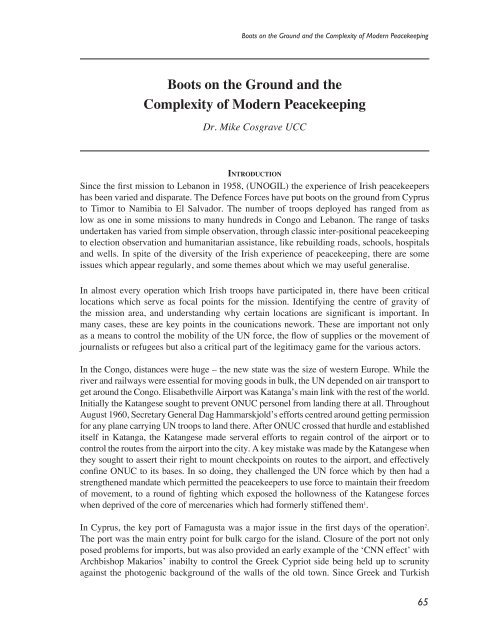Defence Forces Review 2008
Defence Forces Review 2008
Defence Forces Review 2008
You also want an ePaper? Increase the reach of your titles
YUMPU automatically turns print PDFs into web optimized ePapers that Google loves.
Boots on the Ground and the Complexity of Modern Peacekeeping<br />
Boots on the Ground and the<br />
Complexity of Modern Peacekeeping<br />
Dr. Mike Cosgrave UCC<br />
In t r o d u c t i o n<br />
Since the first mission to Lebanon in 1958, (UNOGIL) the experience of Irish peacekeepers<br />
has been varied and disparate. The <strong>Defence</strong> <strong>Forces</strong> have put boots on the ground from Cyprus<br />
to Timor to Namibia to El Salvador. The number of troops deployed has ranged from as<br />
low as one in some missions to many hundreds in Congo and Lebanon. The range of tasks<br />
undertaken has varied from simple observation, through classic inter-positional peacekeeping<br />
to election observation and humanitarian assistance, like rebuilding roads, schools, hospitals<br />
and wells. In spite of the diversity of the Irish experience of peacekeeping, there are some<br />
issues which appear regularly, and some themes about which we may useful generalise.<br />
In almost every operation which Irish troops have participated in, there have been critical<br />
locations which serve as focal points for the mission. Identifying the centre of gravity of<br />
the mission area, and understanding why certain locations are significant is important. In<br />
many cases, these are key points in the counications nework. These are important not only<br />
as a means to control the mobility of the UN force, the flow of supplies or the movement of<br />
journalists or refugees but also a critical part of the legitimacy game for the various actors.<br />
In the Congo, distances were huge – the new state was the size of western Europe. While the<br />
river and railways were essential for moving goods in bulk, the UN depended on air transport to<br />
get around the Congo. Elisabethville Airport was Katanga’s main link with the rest of the world.<br />
Initially the Katangese sought to prevent ONUC personel from landing there at all. Throughout<br />
August 1960, Secretary General Dag Hammarskjold’s efforts centred around getting permission<br />
for any plane carrying UN troops to land there. After ONUC crossed that hurdle and established<br />
itself in Katanga, the Katangese made serveral efforts to regain control of the airport or to<br />
control the routes from the airport into the city. A key mistake was made by the Katangese when<br />
they sought to assert their right to mount checkpoints on routes to the airport, and effectively<br />
confine ONUC to its bases. In so doing, they challenged the UN force which by then had a<br />
strengthened mandate which permitted the peacekeepers to use force to maintain their freedom<br />
of movement, to a round of fighting which exposed the hollowness of the Katangese forces<br />
when deprived of the core of mercenaries which had formerly stiffened them 1 .<br />
In Cyprus, the key port of Famagusta was a major issue in the first days of the operation 2 .<br />
The port was the main entry point for bulk cargo for the island. Closure of the port not only<br />
posed problems for imports, but was also provided an early example of the ‘CNN effect’ with<br />
Archbishop Makarios’ inabilty to control the Greek Cypriot side being held up to scrunity<br />
against the photogenic background of the walls of the old town. Since Greek and Turkish<br />
65
















